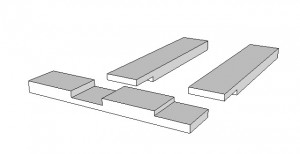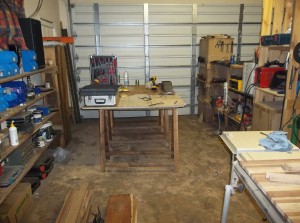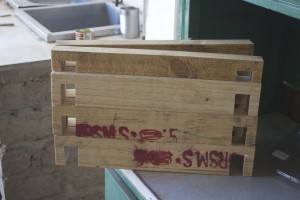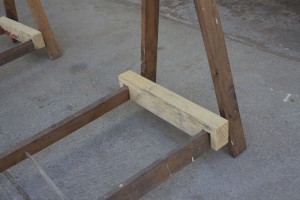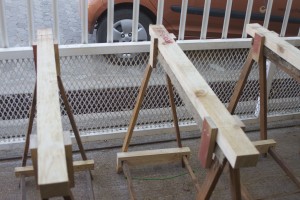In this post I want to document what must be officially the longest time it took me to get to the current product. These four saw horses were first built in 1999 when we still lived in South Africa. Essentially they consist of two scrap Swarthout frames joined at the apex by a single full length piano hinge. The frames were glued and screwed together using simple lap joints as seen below. The legs are restricted from opening up too far by bits of rope. I stapled an old piece of carpet to the apex to soften it up a bit for finishing tasks.
In these pictures you can appreciate one of the major advantages of these saw horses. They can be stored out of the way taking up very little shop space, which is often a problem with this must-have shop aid. You can see how I made two wooden (scrap pine) brackets that keep them sitting on the wall quite happily. As an added bonus you can appreciate my 4 year old daughter’s art.
In the first picture below you can see them lined up in front of the shop were they do most of their work these days. From the next couple of pictures it might be more apparent what one of the weaknesses of this type of sawhorse is. As you can see they used to be the legs of my work surface until I built the workbench/assembly table. You will find a whole series of posts on this project under the category “Bench” if you are interested.
Anyway, the weakness mentioned has to do with the fact that there is nothing that prevents these sawhorses from closing up. This is especially a problem when any pressure is applied square in relation to the sawhorse and horisontally to the top or workpiece they support. This can be very frustrating and unsafe depending on the activity.
In order to solve the above problem while wanting to keep the advantage of the sawhorse’s storability, I made the objects below that I do not have a good name for. They simply drop over the frame forming the lower part of the legs and completely curbs the problem discussed above.
The next modification was done at the same time as the above. One of the most common tasks I use these sawhorses for is to cut rough boards with my Festool TS 55 Cirlcular Saw into more manageable chunks. For this purpose I made these sacrificial beams to sit on top of the sawhorse. They are easy to install and remove and allows me to have the rough boards very stable on the sawhorses, while not having to worry about cutting into them.

